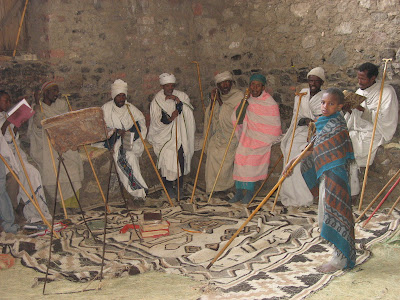(March 20, 2007: Lalibela.)
Na'akuto La'ab is a small church built under a natural cave found about 7 km outside of Lalibela, in the little village of Na'akuto La'ab on the way to the airport. It was built on the site of what was probably an older shrine by Lalibela's successor, King Na'akuto La'ab (13th century). The relatively modern inner red-brick building was added by the Empress Zewditu (20th century).
We visited Na'akuto La'ab in the early hours of the morning, giving ourselves enough time to get to the airport three hours or so before our scheduled flight in order to go through the check-in process and security checks.
This might have seemed like much too much time to me, especially when I saw the quiet at the in-country airports around Ethiopia. I wasn't even sure that our flight in and out of Lalibela was not the only plane that landed that day! However, as our group leader Danny confirmed in an email that described the trials he went through with the next group he took through Ethiopia, an Ethiopian airlines flight may arrive two hours early, a flight that we have been told will be a direct, non-stop flight, may actually end up making one or two stops or a flight may be cancelled altogether for that day. Poor Danny was on his cell-phone constantly, to reconfirm arrangements, but it happened anyway.
I guess I'm grateful that it didn't happen to our group, but then again, Danny did an excellent job of smoothing the way on many occasions I'm sure we were never aware of. Sitting at airports for 2-3 hours just waiting would have been very frustrating if I had not come prepared with a couple of paperback novels.


Inside the outer security wall, we found a group of dabtara chanting some of the extensive and complex liturgy of the Ethiopian church. With some faltering upon our distracting entry, they however kept up the repetive, wailing chant while we wandered about.
Our guide (sorry, I have forgotten to find out what his name was), as was his habit, sat us down to give us a short summary of the history of the church, then led us first to view the treasures kept here (crowns, crosses, icons, an illuminated Bible and a gold-painted drum).


Then we went deeper into the sanctuary where holy water drips from the roof of the cave into several stone basins. No, I didn't have the nerve to sample any of the water; one, because I, particularly as a woman might be overstepping bounds of propriety; two, because I didn't fancy picking up some water-born bug that might make me ill so early on in my trip!

Heeding the warning that wandering about on the rug and rush covered floors of the rock-hewn churches of Lalibela would be a flea-infested experience in our sock feet, I did slather on the insect-repellent the first day. However, that proved to be completely unnecessary there and throughout the whole of the rest of my time in Ethiopia. Mosquitoes also were not a problem at the high altitudes. I did not even see mosquito netting until I was in the lakes' district south of Addis Ababa near the end of my trip! One of our group did get several bites along her inner forearms at the very beginning of our trip in Lalibela and I also had similar bites much later on, perhaps acquired while trekking. While the other girl's bites became inflamed and itched severely, I had no reaction to my bites at all. I was never quite certain what had caused them and although they itched a little, they quickly healed up.
Most of the young boys and girls who engaged us in conversation in Lalibela were scrupulously clean, even though their clothes might have been ragged and worn. However, toddlers and children who did not seem to be attending school, playing in the everlasting dust, were ... dusty!
Lalibela often suffers from water shortages. I can't imagine being a poor mother trying to keep children clean and healthy without plenty of water!






Ah! So
that's how it's done! I am always curious about how the
tukuls are built. Needless to say, this is not what I expected. Like a lot of things in life, my expectations are often turned on their head!

Danny, our group leader, kept trying to hurry us back to the bus so that we'd be on time at the airport. How
can one hurry through scenery like this, I ask you!!


 Anyhow, back to Na'akuto La'ab.
Anyhow, back to Na'akuto La'ab.























2 Comments:
Kati, I have been "lurking" instead of "commenting" because I don't have anything to add to this conversation... but I want to let you know how much I am thoroughly enjoying all of these posts. It's such a beautiful and simple place, and your love for it shines through in these photographs.
The man in the orange shawl who is sitting on the wall... what is his story? He makes me want to go sit next to him and just... just be.
In fact, I really want to paint him. That's an odd feeling for me... maybe I will explain it sometime, but suffice it to say that after burning most of my work in a bonfire 13 years ago, I haven't much picked up a brush since. And yet I really want to paint him. Wow.
God, Kim! I appalled that you burned your work, but you probably had good reasons at the time! It just hurts me to think of it. I think the man in the orange was a priest, but we hardly had time to talk to him, I felt so rushed that morning. You have my permission to use the photograph to paint him, by all means, please. And any time you would rather "lurk" than comment, you are welcome!
Post a Comment
<< Home